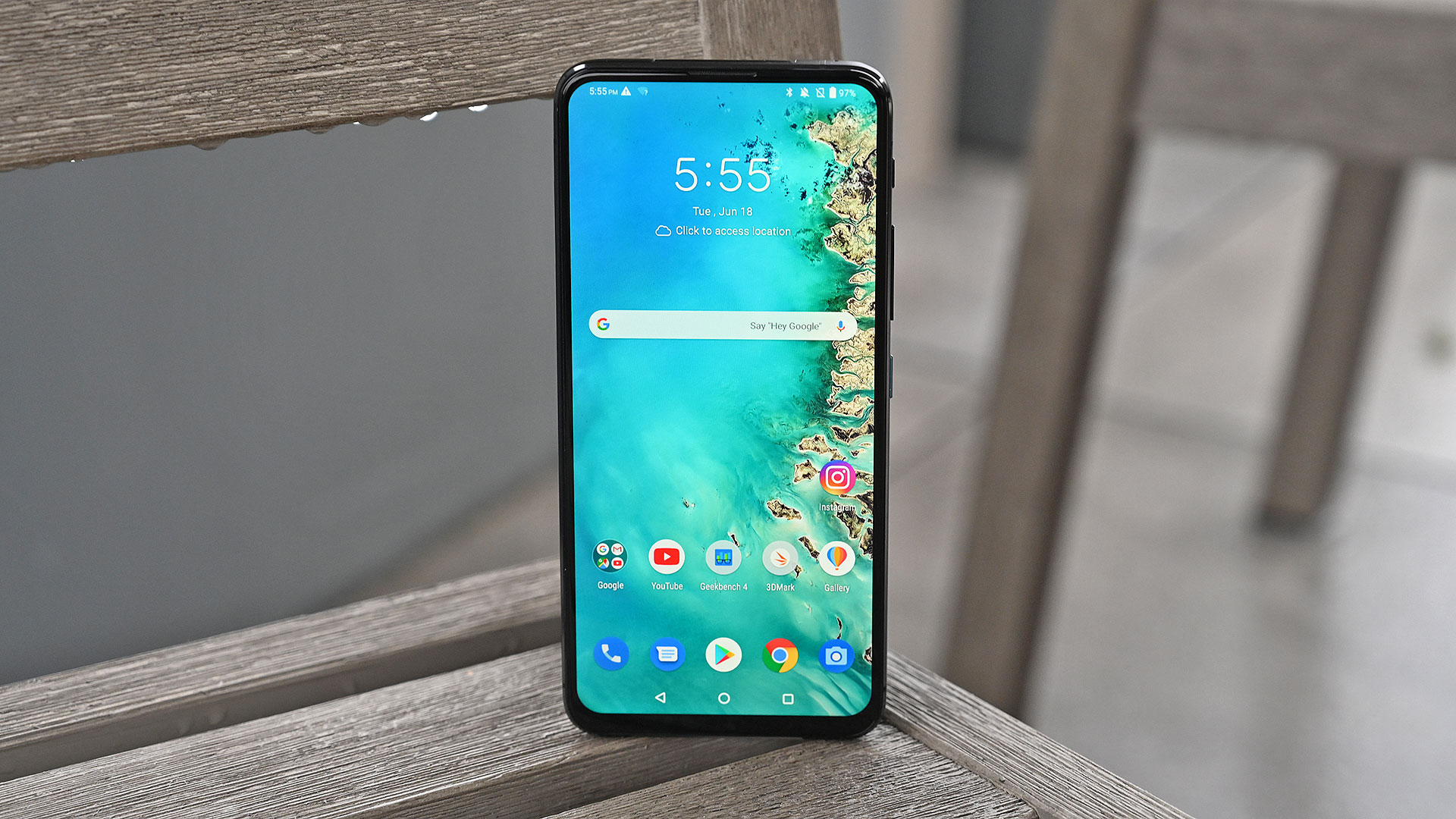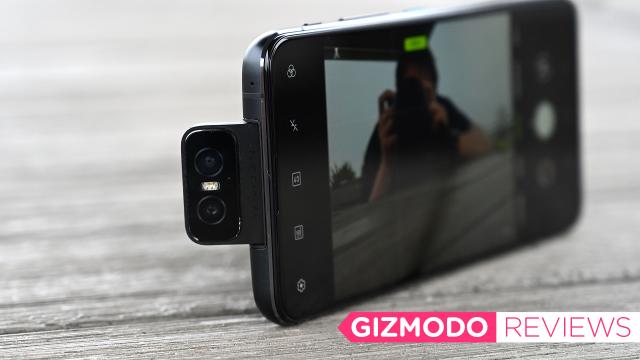Almost as quickly as notches appeared on phones, phone makers started looking for even more aggressive ways to hide a selfie cam including things like punch holes and hidden pop-ups. But even among the rare handsets with motorised cameras, the Asus Zenfone 6 stands alone. This thing is powerful, affordable, and unlike most of its competitors, it has personality.
Editor’s Note: This bad boy isn’t available in Australia, sorry!
That’s because, in addition to letting the phone’s rear cam transform into a selfie cam at a moment’s notice, the camera’s innovative powered hinge also lets you capture every angle in between. In a way, it’s almost like having a phone that’s mounted to one of those fancy slider rigs used in video shoots. Using a handy software slider, you can angle the camera from side-to-side, or switch to a 125-degree ultra-wide angle lens if you need a bigger view. The only thing it can’t do is zoom, but then again, I suppose you’ve got your legs for that.

Zenfone 6
What is it?
Asus' flagship phone with big specs and a funky motorised camera
Price
$US500 ($730)
Like
Great value for specs, no notch, motorised reversible camera, solid build, headphone jack
Don't Like
No water resistance or wireless charging, no support for Verizon or Sprint, 6.4-inch screen is big and bright, but not as colourful as competing OLED-equipped phones
But manual camera controls are just the start, as Asus also added some nifty features that take advantage of the Zenfone 6 camera’s adjustability. The first is a special panorama mode that automatically swings the camera up to a full 180, capturing every angle along the way before stitching everything into a single extra-wide image. But perhaps even more impressive is the Zenfone’s motion tracking feature, that takes advantage of the camera’s motorised hinge to follow a selected subject, and hopefully keep them in frame.
Granted, both of the features are somewhat specialised, but for vloggers or mobile video fanatics, the Zenfone 6 still offers a list of camera features that you can’t really get on other devices. Also, for a phone not made by Huawei, the Zenfone’s image quality ain’t bad.
In a shot of some happy cows, the Zenfone 6 captured a bright, colourful photo that anyone would be happy to post on Instagram. Though, if you zoom in a bit, you can see that Asus’ image processing has resulted in some over sharpening. Next, in a handful of head-to-head comparisons, the Zenfone 6 mostly kept pace with the Galaxy S10+ when snapping a pic of Buddha in a dimly lit restaurant. Even though the Galaxy S10+ did edge out the Zenfone 6 thanks to a slightly brighter exposure and finer details on the brick in back, the Zenfone wasn’t that far behind.
In shootout to snap some freshly steamed dumplings, the Zenfone 6 once again mostly kept up with the Pixel 3, though Google’s HDR+ processing did give the Pixel’s pic an advantage in colour saturation. However, the one area where Asus can’t quite compete is in very low light situations. That’s because while Asus did give the Zenfone 6 a dedicated night mode, it can’t really touch what Google is doing with Night Sight. Just check out the two pictures of a local street mural with and without each phone’s respective night mode turned on to see what I mean.
However, as fun and novel as the Zenfone’s camera is, it wouldn’t be enough to save the device if everything else was garbage. Thankfully, that’s not the case, because despite sporting a price tag of around $US500 ($730), the Zenfone 6 has flagship-level specs including a Qualcomm Snapdragon 855 processor, 8GB of RAM, up to 256GB of storage, a built-in microSD card slot, and a headphone jack. That’s the same as what you get on a Samsung Galaxy S10, though the S10+ does come in a config with 512GB of storage if you need it. Asus has even kept a very light touch on Android 9, offering near stock version of Google’s mobile OS.
Oh, and the 5,000 mAh battery in the Zenfone 6 is just ridiculous. On our video rundown test, it lasted 15 hours and 9 minutes. This puts Zenfone 6 on the same level as much more expensive phones like the Huawei P30 Pro (15:24) and the Galaxy S10+ (15:09), and with Asus’ newly implemented 18-watt quick-charging, you’ll be able to juice it back up faster too.
Other differences between the Zenfone 6 and the Galaxy S10 include a rear capacitive touch fingerprint sensor instead of one that’s built into its screen, and a dedicated voice assistant button that by default summons Google instead of Bixby—which is a switch that probably won’t upset anyone. You even get stereo sound thanks to the Zenfone’s use of a bottom-firing speaker that works in conjunction with the thin speaker grille located above the display.
The Zenfone 6 is missing a few staples you tend to get on more expensive phones though, such as support for wireless charging and water-resistance. On a phone in this price range, the lack of wireless charging is sad, but somewhat understandable, while the lack of wireless charging is almost certainly due to the powered motor that allow the phone’s camera to tilt up and down.
But since the Zenfone 6’s camera is also what allows it to not have any distractions taking away from its big, 6.4-inch screen, it might be worthwhile compromise, particularly if you aren’t a big fan of taking selfie. With a peak brightness of 577 nits, the Zenfone 6 has no issues with outdoor visibility, but because Asus opted for an LCD panel instead of OLED, colours aren’t quite as rich or vibrant as what you’d see on a OnePlus 7 or Galaxy S10.
But here’s the big question: How long is that motorised camera going to survive. Honestly, I have no idea. Asus claims the Zenfone 6’s camera has a reinforced motors with 13 gears, which should give the phone some much-needed toughness. And when you set up the camera to also unlock the phone using face recognition, the speed at which the camera comes to attention is actually pretty impressive.
But in manual mode, tilting the camera isn’t really what I’d call smooth, and the whole time you use it, you can feel those motors whirring away inside. That means depending on who you ask, the Zenfone’s popup cam is a whimsical call back to something like a motorised Erector sets, or a haunting reminder of the phone’s fragility.
So even though I spent a good chunk of my time with the Zenfone 6 worrying if its motorised camera was about to conk out, I still can’t help but appreciate what Asus had created. Compared to other phones in this price range like the Moto Z4 or the OnePlus 6T, the Zenfone 6 offers better specs, better battery life, and something else you don’t find in a lot of phones: personality. The harder choice is trying to choose between the cheaper $US400 ($584) Pixel 3a and its flagship-class cameras, or the novel camera and brawny components of the Zenfone 6. In many ways, the Zenfone 6 is a better value, but at the same time I know not everyone can handle a phone this funky.
README
-
The Zenfone 6’s specs are as good as a Galaxy S10, but for half the price.
-
The Zenfone 6 doesn’t have support for CDMA networks, which means anyone on Verizon or Sprint is out of luck.
-
Unlike most pop-up cameras that only have two positions (up or down), the Zenfone 6’s 48-MP camera is adjustable throughout its entire range of motion. (It even works in third-party photo apps like Instagram too.)
-
With a time of 15 hours and 9 minutes on our rundown test, the Zenfone 6 has stupidly good battery life.
